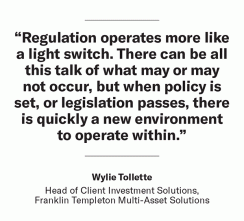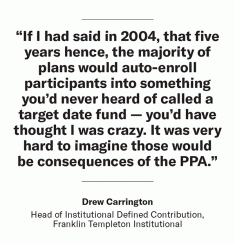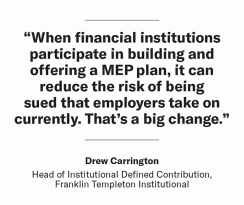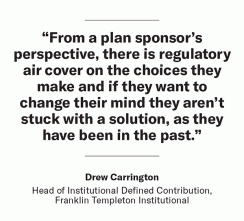The investment experts at Franklin Templeton spend a lot of time speaking to chief investment officers about “What if . . .?” That is, the most beneficial discussions come from exploring the implications of what might happen – not guessing the future – and being prepared for those risks.
In the following conversation, three key players at Franklin Templeton – Wylie Tollette, Head of Client Investment Solutions, Gene Podkaminer, Head of Multi-Asset Research Strategies, and Drew Carrington, Head of U.S. Institutional Defined Contribution – talk through the “what if” of regulatory change, including how it “acts like a light switch” and “changes incentives.”
Gene Podkaminer: Let’s begin by reminding ourselves of the points in our last discussion of regulations. The difference with a regulatory shock is that it changes the rules of the game. None of the other types of shocks – growth, interest rates, inflation, or demographics – do that.

Wylie Tollette: As compared to the long-winding road of demographics that you can see a mile away, regulation operates more like a light switch. There can be all this talk of what may or may not occur, but when policy is set, or legislation passes, there is quickly a new environment to operate within.
Drew Carrington: And pension legislation in the U.S. continues to be one of our favorite topics – and a good place to explore the consequences of regulation. For starters, depending upon the industry, regulation can be a big deal. The U.S. pension industry responds to changes in regulation, particularly in the 401(k) space, and to some extent the corporate defined benefit [DB] space. On the defined contribution [DC] side, features like auto-enrollment existed before the Pension Protection Act [PPA], but only after the passage of the act was there widespread adoption of those features. If I had said in 2004, that five years hence, the majority of plans would auto-enroll participants into something you’d never heard of called a target date fund –you’d have thought I was crazy. It was very hard to imagine those would be consequences of the PPA.

Podkaminer: Slow down, Drew! We’re glad to have you here so we can dig into an applied example. I hear you saying that this is not about innovation. Many of the new features had previously existed for an extended period of time. The difference is the encouragement, the nudge, that regulation provides.
Carrington: Correct. Similarly, on the DB funding side, a debate about de-risking and liability-driven investment was happening prior to the passage of the PPA. However, after the act came into existence, companies made a concerted effort to reduce their risk. I remember talking to a person who worked for an automaker, and regarding the early 2000s he said, “We were a giant benefit program that made cars on the side.”
Podkaminer: We are speaking about fit to purpose. Tools existed, but they did not fit until the regulation provided the opening. Regulation flipped the switch.
Carrington: And the regulations provided both protection from litigation and incentives.
Tollette: The regulation had investment implications as well. For example, the demand for long corporate bonds has probably kept the yield curve flatter for much longer than normal. The persistent and very large demand on the long end of the curve is partially due to the changes in pension regulation, where people wanted to de-risk their DB plans.
Carrington: As mentioned last time, we see new legislation enabling open Multiple Employer Plan [MEP] design, which is particularly interesting to think about.
For example, a financial institution, record keeper, asset manager, bank, and trade association could launch a plan and market it to small employers. When financial institutions participate in building and offering a MEP plan, it can reduce the risk of being sued that employers take on currently. That’s a big change.

Tollette: Joe’s Widget Shop makes widgets. They don’t manage money, so the risk of managing someone else’s money and doing it wrong is really scary. But if a financial institution is running the plan, that is their business. They’re not so afraid of taking on fiduciary risk.
A marketplace that isn’t driven by fear of litigation becomes a more competitive marketplace. This may be how we start to see alternatives make their way into more retirement plans. Instead of asking a corporation to bear that risk, financial institutions may stand up and take a manageable level of litigation risk on themselves.
Podkaminer: So, a MEP environment will effectively create a new category of sophisticated buyer, equivalent to large plans. More large plans mean more large players on the financial institution side who may extend to a variety of funds.
Carrington: And we hear plans saying, “This is our lineup. We like active and passive together, and spending our risk and fee budget where it makes the most sense. We’re using asset classes that we might not otherwise make available to participants directly. We’re incorporating them into a diversified portfolio – things like alternatives or illiquids, which we know can produce better returns, as seen in DB plans, endowments, and foundations.”
This will help overcome one of the biggest frustrations for people in the DC business, namely that we have trillions of dollars invested on a long return horizon, yet we run the whole system as if we must be able to liquidate the entire thing tomorrow.
Tollette: That’s the unspoken premise. That structure isn’t optimal, but we woke up one day and there we were. It sounds like coming legislation will potentially create new paths. Maybe we enable more technology and solve the number one question – retirement income. How do we get it? How long can it last? What form does it take?

Carrington: Within this legislation are provisions that affect lifetime income and retirement plans – specifically, the lifetime income safe harbor, lifetime income disclosure, and a mechanism to allow lifetime income product portability. From a plan sponsor’s perspective, there is regulatory air cover on the choices they make, and if they want to change their mind they aren’t stuck with a solution, as they have been in the past. A sponsor can change its mind about which lifetime income product it uses without waiting for all the participants in the current plan to exit. For example, plan participants may have a lifetime income option, but the sponsor decides it wants to change that option. They can push out the benefits that people have accrued up to that point – people get what they’ve paid for – and then the plan sponsor gets a clean start. That’s really important to plan sponsors.
Tollette: The application of technology could open the door to more customization for individuals and the expansion of tools for them to use at the proper time and place.
Podkaminer: It’s like the revolution in health care and gene therapy designed for an individual, where a drug can be designed for a person’s unique ailments. The door may be open to using big data to design or tailor an outcome by individual.
Carrington: Exactly. Many plan participants today don’t ask for retirement income or financial wellness solutions because they don’t know what’s available. It’s like rearview cameras in cars. No driver called up Ford or GM and said, “You know what I really need is a camera for when I back up.” But once you have it and you see it, then you expect it. There will be a lot of that with retirement plans. Individuals will see features in their spouse’s plan, for example, and ask, “How come I don’t have that stuff?”
In the private sector, younger employees change jobs relatively frequently compared to the past. They will be exposed to more plans and have higher expectations for what’s in a plan. There will be increased demand for the kinds of plan features and services that are available today but not in widespread use – financial wellness, emergency savings accounts, retirement income products, managed accounts, and so forth.
Tollette: We’ve been focusing on the U.S. here, but similar light switch moments are possible in other countries around the world. The idea that “capital can support me in retirement” is spreading. No longer does retirement have to mean “I move in with my relatives.” So, lessons learned from more advanced economies matter, and watching pension policies and regulations matters.
Podkaminer: What we’ve been discussing is a case where a regulation change appears to lead toward very positive outcomes. That is, a movement toward the objective of total return portfolios rather than portfolios that are terrified of litigation, along with the potential for more tailored outcomes for individuals.
Tollette: I am glad we didn’t explore an example of a regulatory change with a poor outlook. That would be a difficult conversation and an even more difficult story to read!
Wylie, Gene, and Drew are happy to speak to you about your “what if” scenarios. Feel free to contact them at solutions@franklintempleton.com:
Wylie Tollette, CFA, CPA
Head of Client Investment Solutions
Franklin Templeton Multi-Asset Solutions
Gene Podkaminer, CFA
Head of Multi-Asset Research Strategies
Franklin Templeton Multi-Asset Solutions
Drew Carrington, CFA, CAIA
Head of Institutional Defined Contribution
Franklin Templeton Institutional
More in the series "What if there are shocks to ... "

Franklin Templeton
| 
Franklin Templeton
| 
FT demographics
| 
Franklin Templeton
|

Franklin Templeton
| 
FT-global growth
| 
interest rates
| 
FT
|
Disclaimers:
This material is provided for informational purposes only and nothing herein constitutes investment, legal, accounting or tax advice. This material is general in nature and is not directed to any category of investors and should not be regarded as individualized, a recommendation, investment advice or a suggestion to engage in or refrain from any investment-related course of action. All information is current as of the date of this material and is subject to change without notice. Any views or opinions expressed may not reflect those of the firm or the firm as a whole. Franklin Templeton does not accept any responsibility to update any opinions or other information contained in this document. This material may include estimates, outlooks, projections and other “forward-looking statements.” Due to a variety of factors, actual events may differ significantly from those presented.
CFA® and Chartered Financial Analyst® are trademarks owned by CFA Institute.
For US Residents Only
This site is intended only for U.S. Institutional Investors and Consultants. Using it means you agree to our Anti-Corruption Policy.
If you would like information on Franklin Templeton’s retail mutual funds, please visit www.franklintempleton.com.
Franklin Templeton Distributors, Inc.






